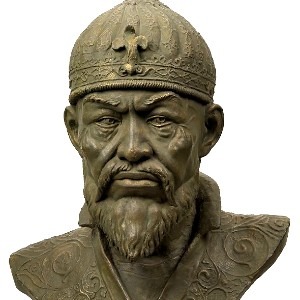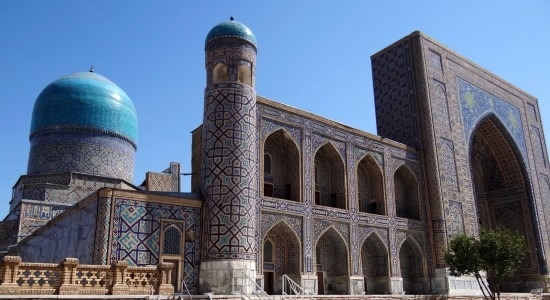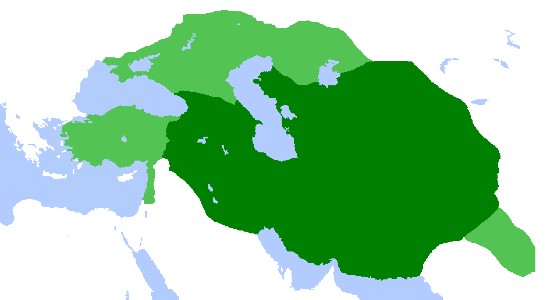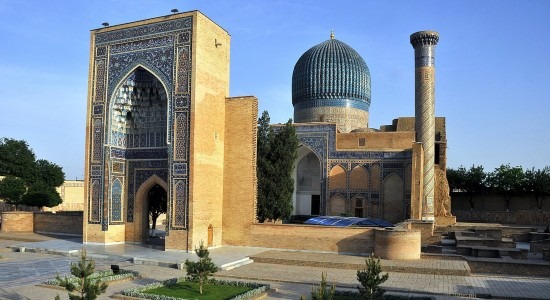MedievalReporter.com
Covering history's most marvelous millennium
Join our newsletter!

Covering history's most marvelous millennium
Covering history's most marvelous millennium
The Timurids were the followers of Tamerlane, also called Timur. He envisioned himself as the second coming of Genghis Khan and – as such – tried to restore the Mongol Empire. The Timurids were therefore highly ambitious and overran large parts of Central Asia and the Middle East.
Timurid expansionism bolstered Silk Road trade, reinvigorated muslim culture and art and reenergized a corner of the world that had dozed off somewhat after the Mongol conquest. Additionally, Timur’s late medieval empire was one of the last bouts of Asian world empire building before the Europeans took up the mantle of devouring civilizations whole.
This is a short intro from our Medieval Guidebook. Dive deeper into the subject by reading our articles about it.

Tamerlane (actual name: Timur) was a late medieval Turco-Mongol conqueror who went undefeated throughout his career. Therefore, he is widely regarded as one of history’s greatest military leaders. He called himself the “Sword of Islam”. While scoring victory after victory, Timur was also a great patron of the arts. His cultural endeavors created an atmosphere now known as the Timurid Renaissance.
Timur was born in Transoxiana (modern Uzbekistan) in the 1320s CE. The area was then under control of the Chagatai Khanate, one of the successor states to the Mongol Empire. His father was a nobleman of considerable wealth. From an early age, Timur was renowned for his military skills and successes. Later, instability engulfed the khanate as several warring factions emerged.
Timur tactfully played one faction against the other, whilst reaping the biggest results for himself. In the meantime, he made himself popular with the common people and Silk Road merchants by keeping taxes low. However, he was faced with a pesky problem that obstructed his ambitions. Timur was vaguely related to, but not directly descended from, Genghis Khan. According to Mongol law, he could therefore not claim the title of khan.
So Timur pragmatically set up a “puppet khan”, a direct descendant of Genghis who he could bend to his will.

With the Chagatai Khanate now firmly under his control, Timur set out to expand his empire. Another Mongol successor state, the Ilkhanate in Persia, was also in disarray. Sweeping through Afghanistan, the Timurids invaded Persia from the east, reducing resistant cities to rubble in true Mongol fashion. At one place, after a tenous siege, Timur even went as far as cementing the surrendered soldiers inside the walls they had been defending. After ten long blood-soaked years, he had completely broken the various factions in Persia and integrated this old land with his khanate: the Timurid Empire became a reality.
Only five years later, Timur let his eyes fall on India. He invaded the Sultanate of Delhi. The sultan resisted the Timurid invasion with massive armies but was beaten nonetheless. In 1398, Timur captured Delhi itself, one of the richest cities in the world at that time. The massacre that followed took so many lives that it would take the city over a century to recover.
In the meantime, Timur and the Ottoman sultan Bayezid had been exchanging insulting letters with each other for years. Fed up with all the slights addressed at him, Timur invaded the Ottoman Empire. At the Battle of Ankara, he captured Bayezid, leaving the Ottoman state without a ruler for twelve years. Having conquered Persia, Anatolia, the Levant, Central Asia and northern India, the Timurids had two major regions left to subjugate if they were to restore the Mongol Empire: Imperial China and the Mongol heartland itself.
Another offensive letter, in which the Chinese emperor treated Timur as a subject, gave him the perfect pretext to invade both.

– advertisement –
– article continues below –
Whilst gathering all the forces he could muster for the invasion of the East, Timur died in the south of modern-day Kazakhstan. The invasion of China came to nothing, as multiple princes pursued their claims to the throne. A civil war erupted that lasted for four years. It greatly weakened the Timurid Empire. But from 1409 to 1447, one of Timur’s sons managed to hold on to the eastern rump of the state: Persia, Uzbekistan and Afghanistan.
Control of the Silk Road trade still made sure the Timurid coffers were filled to the brim. Timur’s successors sponsored art and architecture as much as he did. But over time, they couldn’t keep their enemies back. The Timurids lost their Persian territories one by one to Turkoman confederacies invading from the west. Their Central Asian dominions were conquered by the Uzbeks.
Lacking Timur’s galvanizing leadership, the Timurid Empire was no more by the end of the 15th century. Its crimson conquests had cost over 17 million lives. However, one of Timur’s descendants managed to take up the mantle of empire-building. His great-grandson Babur followed in his footsteps and invaded the Delhi sultanate once more. Babur then proceeded to conquer India and founded the Mughal Empire in the process.
The Timurid legacy thus continued well into the Early Modern Era.

Disclosure: we work hard to provide you with exclusive medieval reports and guides. To make the Middle Ages accessible to everybody, we’d like this information to remain FREE. Therefore, some of the links below are affiliate links, meaning – at no additional cost to you – we will earn a small compensation if you click through.
Grab a short intro on another civilization from our Medieval Guidebook.
Featured Image Credit: Stannered (Wikimedia)